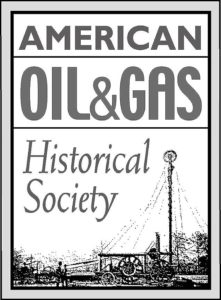by Bruce Wells | Mar 23, 2016 | Petroleum Companies
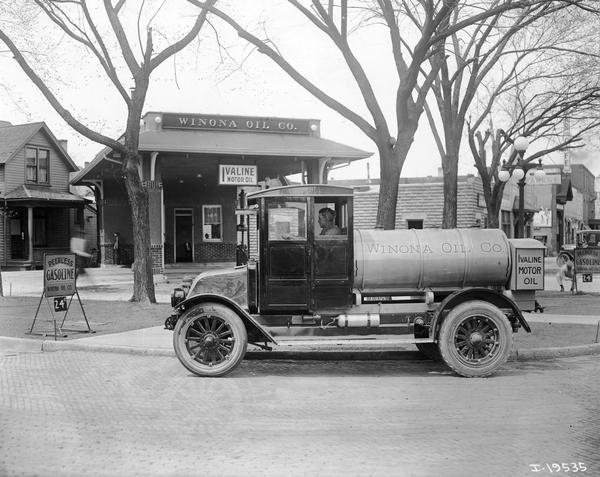 During World War I, the Winona Oil Corporation set up operations in Casper, Wyoming, with holdings of 1,200 acres of “selected land in the heart of Powder River.” The company reported having one rig ready to drill and another ready to be “rigged up” at another site. With capitalization of only $200,000, Winona Oil was considered a “poor boy” drilling venture dependent upon investors to fund continued drilling despite setbacks and risks. The company offered stock at 5 cents a share. Advertisements in the Ogden Standard enticed investors with “Winona Is Here to make Money, Money, Money.”
During World War I, the Winona Oil Corporation set up operations in Casper, Wyoming, with holdings of 1,200 acres of “selected land in the heart of Powder River.” The company reported having one rig ready to drill and another ready to be “rigged up” at another site. With capitalization of only $200,000, Winona Oil was considered a “poor boy” drilling venture dependent upon investors to fund continued drilling despite setbacks and risks. The company offered stock at 5 cents a share. Advertisements in the Ogden Standard enticed investors with “Winona Is Here to make Money, Money, Money.”
In February 1918, C. Kirchner, secretary of the Winona Oil, conducted a promotional demonstration of the reduction of shale oil to gas for about 50 onlookers. “This gas was lighted and burned during the entire experiment to such an extent that a couple of engineers in the party made the remark that the gas itself would furnish 90 per cent of the fuel necessary for the original reduction,” it was later proclaimed. This Winona Oil interest in shale oil did not develop, although other contemporary ventures did pursue it (see Ute Oil Company).
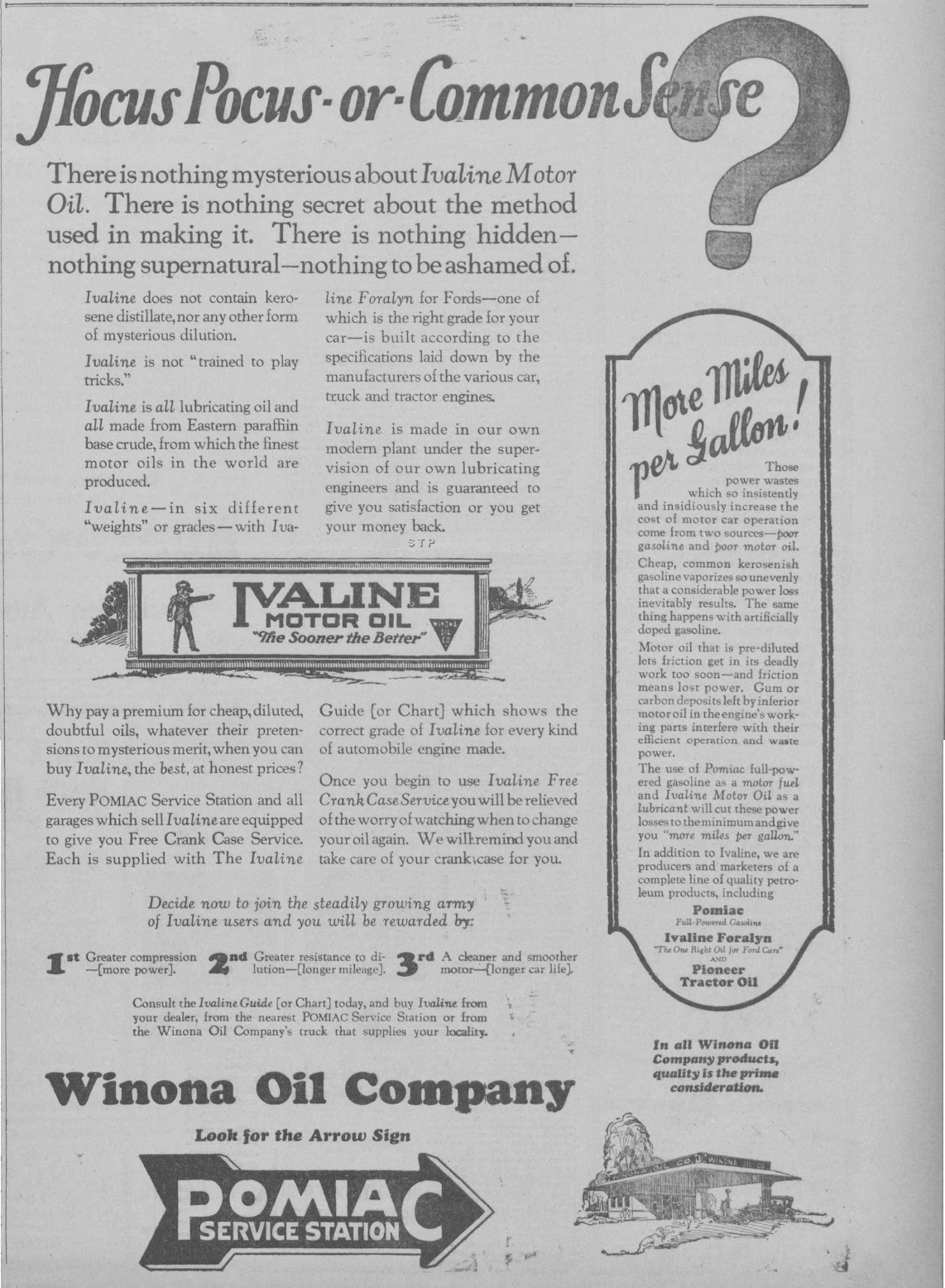 Winona Oil by 1919 had only been able to drill 700 feet in its first drilling effort somewhere “on the north side of the railroad.” In March it was reported that “the Powder River Syndicate has undertaken to finish the well commenced by the Winona Oil Corporation at Powder River, Natrona Co., according to reports current in Casper.” Another article in the Oil & Gas News noted, “In the Powder River field, the Winona Oil Corporation has announced the purchase of a drilling machine which will be used to complete the company’s first well, which has been underway for months. The Winona claims to have solved all its difficulties, and expects to go with its work without further delay.”
Winona Oil by 1919 had only been able to drill 700 feet in its first drilling effort somewhere “on the north side of the railroad.” In March it was reported that “the Powder River Syndicate has undertaken to finish the well commenced by the Winona Oil Corporation at Powder River, Natrona Co., according to reports current in Casper.” Another article in the Oil & Gas News noted, “In the Powder River field, the Winona Oil Corporation has announced the purchase of a drilling machine which will be used to complete the company’s first well, which has been underway for months. The Winona claims to have solved all its difficulties, and expects to go with its work without further delay.”
By the end of May 1919, Winona Oil was reported to have survived its financial difficulties and reentered the field. Plans were by then underway to drill a second well. Good news came the following month when the first well was described as “gassing heavily, and Casper people interested in the enterprise are very optimistic over the prospects. Should the well prove a good one, a large tract north of Powder River station would be added to the territory considered proven.”
But by August the good news had gone bad; the gasser well had to be was abandoned, “as the hole was started with a casing too small to see it thoroughly.” A second well was spudded by the Powder River Syndicate with Winona Oil a fifty-fifty partner. “The Winona Powder River Syndicate well No. 2., which was begun when the first hole pinched-out, is making 100 feet a day, according to reports from the field, and is down about 500 feet. This well is located north of Powder River, on Winona holdings,” noted the Oil & Gas News on September 4, 1919. The trade publication reported bad news several months later.
“The Winona well at Powder River is also shut down, but it is claimed that drilling will resume in the spring. This is the second well, the first having been lost on account of a bit wedged in the hole,” Oil & Gas News reported on January 29, 1920. Drilling did not resume in the spring or anytime thereafter. Despite the efforts of Winona Oil and the hopes of its stock investors, the company did not survive. Cities Service Company bought Winona Oil and moved the Winona division to St. Paul, Minnesota.
___________________________________________________________________________________
The stories of exploration and production companies joining petroleum booms (and avoid busts) can be found updated in Is my Old Oil Stock worth Anything? The American Oil & Gas Historical Society preserves U.S. petroleum history. Please support this AOGHS.ORG energy education website. For membership information, contact bawells@aoghs.org. © 2018 Bruce A. Wells.
___________________________________________________________________________________
by Bruce Wells | Jan 27, 2016 | Petroleum Companies
The land around Bristow, Oklahoma, was once dismissed as “condemned territory” and deemed unproductive by geologists. Thirty-five dry holes had substantiated their judgement, despite the location between two of Oklahoma’s most productive oilfields, Cushing-Drumright and Glenn Pool.
The Cushing-Drumright field, about 30 miles northwest of Bristow, was discovered by Oklahoma’s “King of the Wildcatters,” Tom Slick, in 1912. Once known as “Dry Hole Slick,” his Wheeler No. 1 well revealed an oilfield that produced a lot of oil for the next 35 years, reaching 330,000 barrels of oil every day at its peak. With its pipelines and vast storage facilities, Cushing today is the trading hub for oil in North America.
Thirty miles east of Bristow, the Glenn Pool field was discovered on the Creek Indian Reservation south of Tulsa in 1905 – two years before Oklahoma statehood. Combined with the earlier “Red Fork Gusher,” Glenn Pool would help make Tulsa the “Oil Capital of the World.”
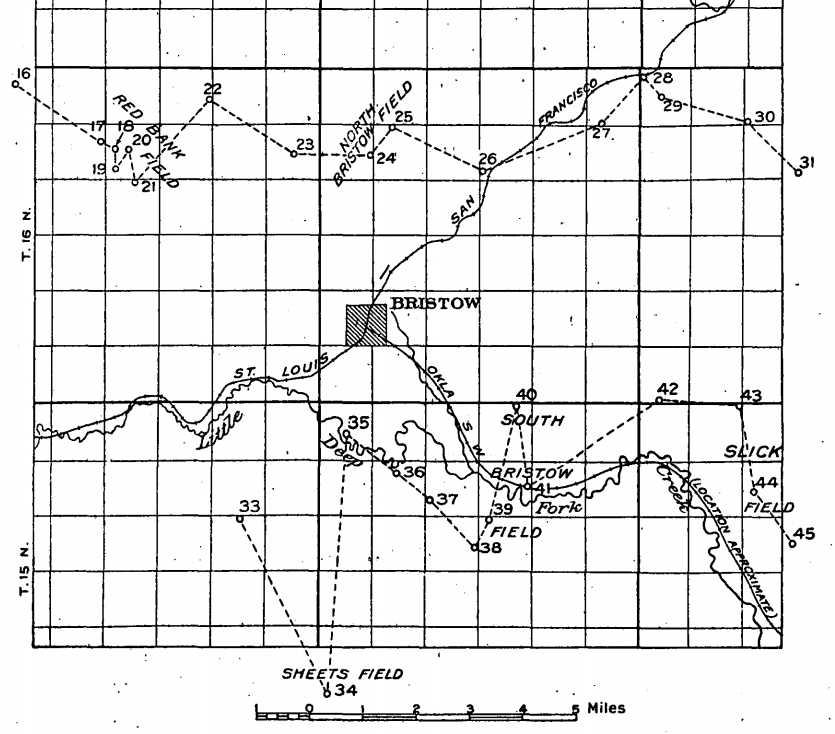 Despite the Bristow area’s dry holes between the giant oilfields, Continental Petroleum Company attempted an exploratory well just east of the town. On October 17, 1921, its Ben Sharper No. 1 well was completed with oil production of 1,000 barrels a day. It was the discovery well for what became known as the Continental Pool. The success soon drew many competitors and Bristow’s population soared.
Despite the Bristow area’s dry holes between the giant oilfields, Continental Petroleum Company attempted an exploratory well just east of the town. On October 17, 1921, its Ben Sharper No. 1 well was completed with oil production of 1,000 barrels a day. It was the discovery well for what became known as the Continental Pool. The success soon drew many competitors and Bristow’s population soared.
Continental Petroleum had been formed as a Delaware corporation in January 1919, with former Colorado banker A.A. Rollestone as president. Rollestone had also purchased and was president of Continental Refining Company, which operated a 2,500 barrel-a-day refinery in Bristow, where both companies were located.
One Rollestone company was in the oil exploration business and the other was refining crude oil piped in from the Cushing-Drumright field. Moody’s Analyses of Investments reported Continental Petroleum had about 6,000 acres under lease in Oklahoma and another 3,000 acres in Texas.
Continental Petroleum’s success with the Continental Pool brought suitors. In January 1922, stockholders approved purchase of the company by Michael L. Benedum’s Transcontinental Oil Company.
Benedum, a successful independent oilman from Pittsburgh, Pennsylvania, in 1924 formed the Big Lake Oil Company, which built the first oil company town in the Permian Basin in West Texas. A 1923 wildcat well there, the Santa Rita No. 1, had uncovered the 300-mile basin. He would also be known as “King of the Wildcatters.”
The Transcontinental Oil buyout of Continental Petroleum made A.A. Rollestone a wealthy man, according to the trade publication the Petroleum Age, which said the deal gave him an address “on a prominent Easy Street corner.”
In 1936, the Ohio Oil Company (later Marathon), acquired Transcontinental Oil Company. Although Continental Petroleum stock certificates, redeemed and canceled long ago, have no value as negotiable securities, the company’s Oklahoma oil patch history may help make them collectable.
___________________________________________________________________________________
The stories of exploration and production companies joining petroleum booms (and avoiding busts) can be found updated in Is my Old Oil Stock worth Anything? The American Oil & Gas Historical Society preserves U.S. petroleum history. Please support this AOGHS.ORG energy education website. For membership information, contact bawells@aoghs.org. © 2018 Bruce A. Wells.
___________________________________________________________________________________
by Bruce Wells | Nov 2, 2015 | Petroleum Companies
The first Louisiana oil well revealed the Jennings oilfield in 1901 – just nine months after the historic “Lucas Gusher” at Spindletop Hill in nearby Beaumont, Texas. The discovery launched the Pelican State’s petroleum industry. Read more in First Louisiana Oil Well.
Louisiana’s young petroleum businesses boomed in the early 1920s, energized by discoveries of the Monroe natural gas field in 1916, the Homer oilfield in 1919, and Haynesville gas field in 1921.
With abundant investment opportunities – thanks in part to the public’s fascination with “black gold” – oil companies drilled wells to meet growing demand for gasoline. But high exploration and production costs, transportation, refinery hazards and price fluctuations created an unforgiving business environment, then as now. (more…)
by Bruce Wells | Oct 27, 2015 | Petroleum Companies
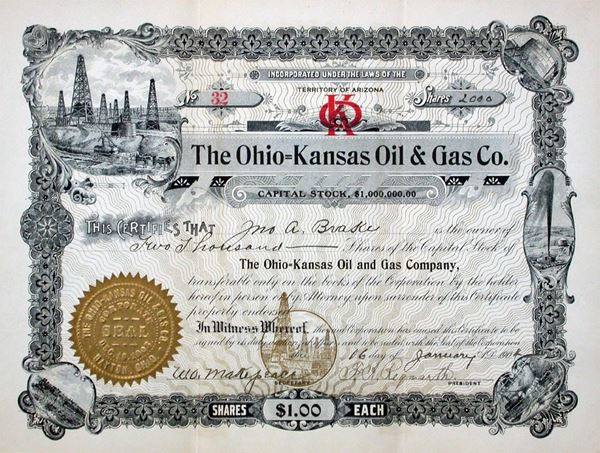
In the early 1900s, the Ohio-Kansas Oil & Gas Company financed drilling operations with capital raised from stock sales. It had wells 12 miles southeast of Burlington, Kansas, and secured a franchise to supply natural gas to the town.
The Burlington Republican newspaper in April 1905 reported that “a prospectus of the Ohio-Kansas Oil and Gas Co., advertising its stock for sale, is in circulation, and a copy has been received here. It is circulated by J.H. Andrews & Co, Broker, 40S Fidelity Trust Co. Building, Kansas City, Mo., who will give all necessary information concerning the matter.” (more…)
by Bruce Wells | Oct 23, 2015 | Petroleum Companies
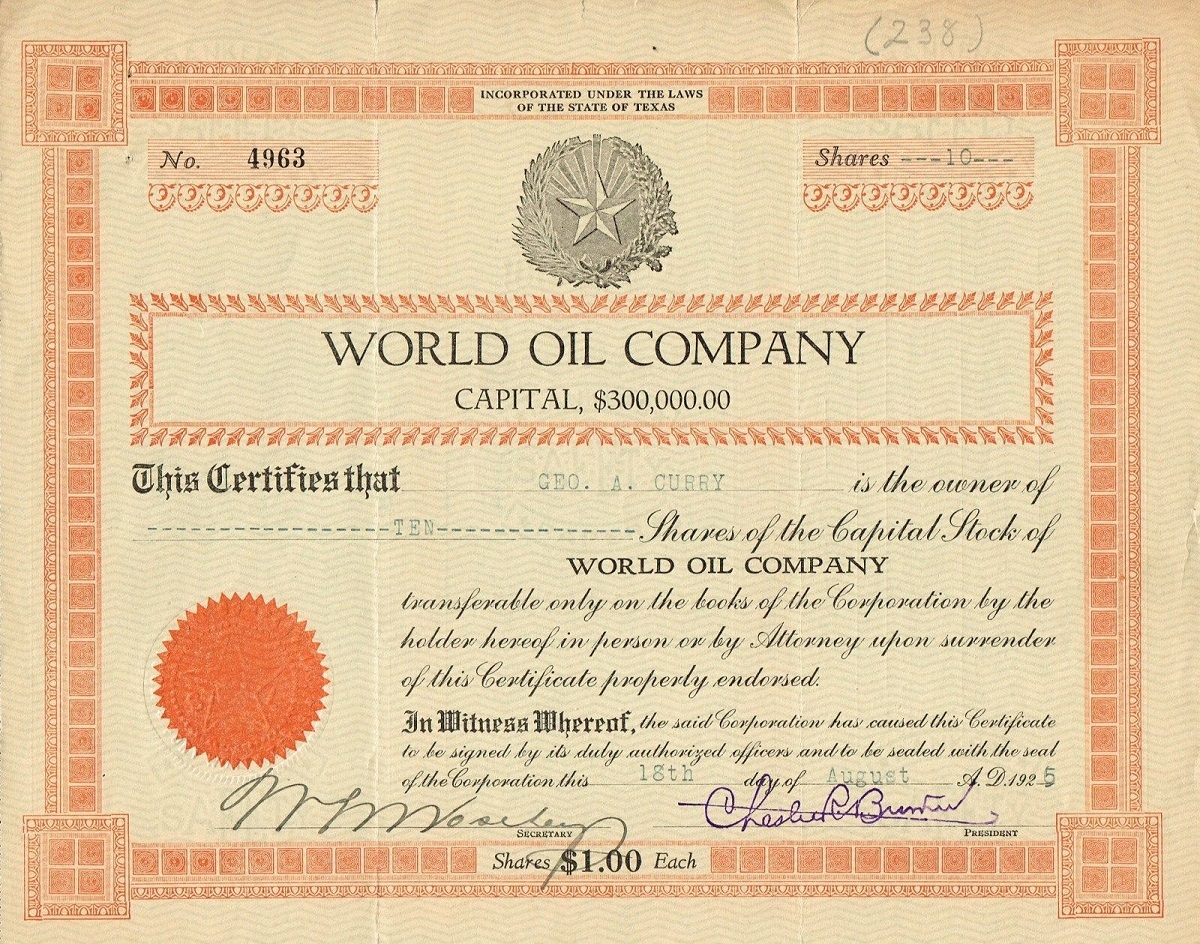 When a shady publisher decided to become a wildcatter seeking oil riches, the end of his story might have been predicted.
When a shady publisher decided to become a wildcatter seeking oil riches, the end of his story might have been predicted.
Ft. Worth publisher Chester R. Bunker, head of the World Company, began by seeking to expand subscriptions to his trade journal, which ostensibly offered readers insights into the booming Texas oil business. The 1917 “Roaring Ranger” discovery well between Ft. Worth and Abilene had brought oilfield discoveries close to home.
Bunker’s Texas Oil World (formerly Western World) was in fact a tip sheet largely for promoting his own business interests. To increase circulation, beginning in 1922 Bunker successively added memberships in his “Texas Oil World Marathon Fold Club” or “Texas Oil World Marathon Fold Drilling Club” as premium inducements for potential subscribers.
These clubs entitled each subscriber to a miniscule interest in any profits that might be drawn from his company’s distant oil leases: “a 1/10,000th interest in all emoluments and profits accruing from certain oil and gas leases of 10,000 acres, more or less in Crockett County, State of Texas, and held in trust for all members by the undersigned trustee.”
Court documents later noted that with Bunker the trustee, “the interests given to the subscribers were simply for the purpose of promoting the circulation of the oil journal and its business, and that neither Bunker nor his corporation were to benefit or profit from the promotions.”
Accordingly, Bunker undertook an unlikely wildcat drilling venture on the company’s remote Crockett County lease in 1923, prompting the offer of another subscription inducement, the “Crockett County Lease Bonus.”
After two years of drilling and to the surprise of all, on June 8, 1925, Bunker’s L.P. Powell No. 1 discovery well was completed at 2,650 feet with daily production of 25 barrels of oil. The well opened the Powell Field and prompted a flood of investors and speculators.
Twelve days after the oil discovery, the World Company – now renamed Bunker Printing & Book Company – negotiated sale of its well and 2,500 acres of its leases in Crockett County to Humble Oil Company for almost $1.4 million. Within two weeks of the Powell No. 1 well, more than $5 million had been exchanged in lease and royalty trades. Humble Oil would later become Exxon thanks to other leases at the King Ranch in Kleberg County.
On June 29, 1925, Bunker chartered the World Oil Company using capital from “assets theretofore belonging to the three clubs.” Subscribers surrendered their membership certificates and became shareholders in World Oil on the basis of $10 for every unit of membership.
World Oil Company searched for oil beyond Crockett County, reportedly drilling wells in Glasscock, Hockley, Pecos, Reeves, Shackelford, Taylor and Tom Green counties. But the company failed despite these exploration efforts.World Oil offered stock to the public through advertisements in Bunker’s publications. The stock’s price advanced from about 70 cents per share to $2.60 per share by September 1926.
According to Oil in Texas: The Gusher Age, 1845-1945 by Roger M. Olien and Diana Davids Hinton, the company was bankrupted by Bunker’s inability to manage the businesses he created; he “drowned them in red ink.” The authors add that he was convicted of mail fraud a few years later. His wildcatting did leave a mark, however.
Today, a Texas historical marker dedicated in 1975 near Ozona notes Crockett County’s first producing oil well. “Powell No. 1 was the beginning of a vital new industry for Crockett County, before 1925 primarily a ranching area. The next important strike occurred in the Crockett Field in 1938. There are currently over 2,000 producing oil and gas wells in the county.”
___________________________________________________________________________________
The stories of exploration and production companies joining petroleum booms (and avoiding busts) can be found updated in Is my Old Oil Stock worth Anything? The American Oil & Gas Historical Society preserves U.S. petroleum history. Please support this AOGHS.ORG energy education website. For membership information, contact bawells@aoghs.org. © 2018 Bruce A. Wells.
 During World War I, the Winona Oil Corporation set up operations in Casper, Wyoming, with holdings of 1,200 acres of “selected land in the heart of Powder River.” The company reported having one rig ready to drill and another ready to be “rigged up” at another site. With capitalization of only $200,000, Winona Oil was considered a “poor boy” drilling venture dependent upon investors to fund continued drilling despite setbacks and risks. The company offered stock at 5 cents a share. Advertisements in the Ogden Standard enticed investors with “Winona Is Here to make Money, Money, Money.”
During World War I, the Winona Oil Corporation set up operations in Casper, Wyoming, with holdings of 1,200 acres of “selected land in the heart of Powder River.” The company reported having one rig ready to drill and another ready to be “rigged up” at another site. With capitalization of only $200,000, Winona Oil was considered a “poor boy” drilling venture dependent upon investors to fund continued drilling despite setbacks and risks. The company offered stock at 5 cents a share. Advertisements in the Ogden Standard enticed investors with “Winona Is Here to make Money, Money, Money.” Winona Oil by 1919 had only been able to drill 700 feet in its first drilling effort somewhere “on the north side of the railroad.” In March it was reported that “the Powder River Syndicate has undertaken to finish the well commenced by the Winona Oil Corporation at Powder River, Natrona Co., according to reports current in Casper.” Another article in the Oil & Gas News noted, “In the Powder River field, the Winona Oil Corporation has announced the purchase of a drilling machine which will be used to complete the company’s first well, which has been underway for months. The Winona claims to have solved all its difficulties, and expects to go with its work without further delay.”
Winona Oil by 1919 had only been able to drill 700 feet in its first drilling effort somewhere “on the north side of the railroad.” In March it was reported that “the Powder River Syndicate has undertaken to finish the well commenced by the Winona Oil Corporation at Powder River, Natrona Co., according to reports current in Casper.” Another article in the Oil & Gas News noted, “In the Powder River field, the Winona Oil Corporation has announced the purchase of a drilling machine which will be used to complete the company’s first well, which has been underway for months. The Winona claims to have solved all its difficulties, and expects to go with its work without further delay.”
 Despite the Bristow area’s dry holes between the giant oilfields, Continental Petroleum Company attempted an exploratory well just east of the town. On October 17, 1921, its Ben Sharper No. 1 well was completed with oil production of 1,000 barrels a day. It was the discovery well for what became known as the Continental Pool. The success soon drew many competitors and Bristow’s population soared.
Despite the Bristow area’s dry holes between the giant oilfields, Continental Petroleum Company attempted an exploratory well just east of the town. On October 17, 1921, its Ben Sharper No. 1 well was completed with oil production of 1,000 barrels a day. It was the discovery well for what became known as the Continental Pool. The success soon drew many competitors and Bristow’s population soared.
 When a shady publisher decided to become a wildcatter seeking oil riches, the end of his story might have been predicted.
When a shady publisher decided to become a wildcatter seeking oil riches, the end of his story might have been predicted.